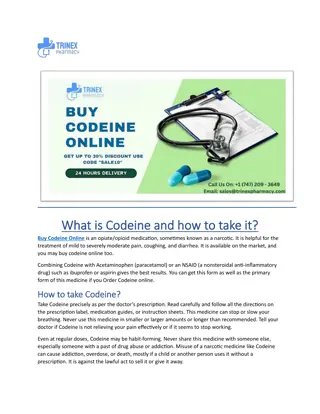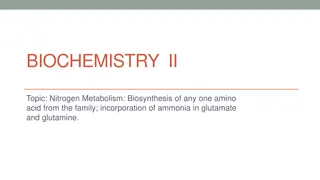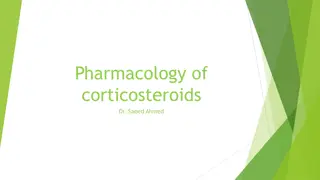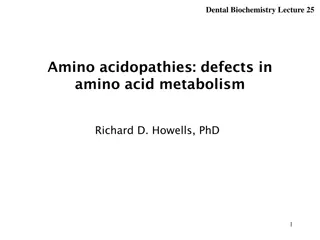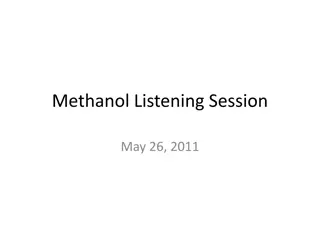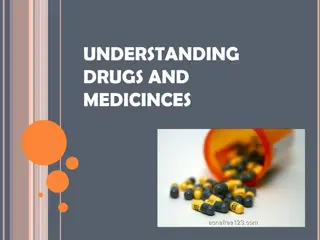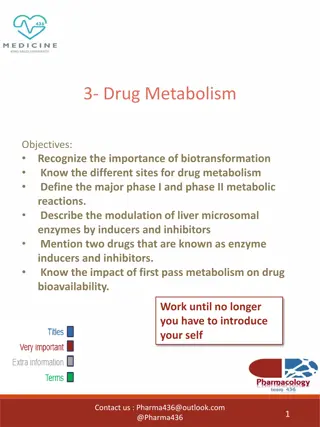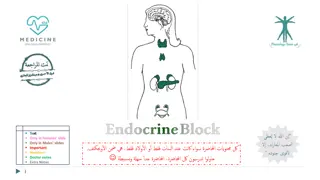Understanding Paracetamol: Usage, Metabolism, and Side Effects
Paracetamol, a widely used non-opioid analgesic, is effective for treating musculoskeletal pains and headaches. This synthetic medication primarily acts in the Central Nervous System and is available in various forms. However, caution is advised due to potential side effects such as rare skin reactions and liver damage. Understanding its metabolism, distribution, and dosage is crucial for safe usage.
Download Presentation

Please find below an Image/Link to download the presentation.
The content on the website is provided AS IS for your information and personal use only. It may not be sold, licensed, or shared on other websites without obtaining consent from the author. Download presentation by click this link. If you encounter any issues during the download, it is possible that the publisher has removed the file from their server.
E N D
Presentation Transcript
GROUP MEMBERS 1. Ojeifo David Oluwaseyi 15/MHS06/044 2. Orisanusi Olajumoke Bukola 15/MHS06/053 3. Osemenam Favour Ifunanya 16/MHS06/077
Introduction Introduction Uses Uses Metabolism Metabolism Side effect Side effect Dosage and caution Dosage and caution Laboratory diagnosis Laboratory diagnosis
FIGURE 1 FIGURE 1
This is a synthetic non-opioid analgesic and antipyretic. It acts mainly in the Central Nervous System. It is widely used for acute musculoskeletal pains and acute headache. It is also called N-acetyl-para- aminophenol (APAP).
It is typically used orally, rectally and intravenously. Effects last between two and four hours. Paracetamol is available as a generic medication with trade names including Tylenol, Disprol, Hedex, Medinol and Panadol.
Fever Pain Headache
It is stated that the drug could cause rare and possibly fatal skin reactions such as Stevens Johnson syndrome (SJS) and toxic epidermal necrolysis Liver Damage
Paracetamol is well absorbed in the gastrointestinal tract. Oral bioavailability is dose dependant: with larger doses, the hepatic first pass effect is reduced due to overwhelming of the liver enzymatic capacity; and therefore, bioavailability is increased.
Paracetamol is distributed throughout the body fluids in a homogeneous way. The analgesic activity is attributable to the small fraction that penetrates into the brain. Paracetamol given at therapeutic doses binds to plasma proteins at less than 20%. In case of intoxication, this proportion may increase to up to 50%. Paracetamol is essentially metabolized in the liver by conjugation with glucuronic acid (55%) and sulfuric acid (35%). Hepatotoxic metabolites are produced in small amounts by the cytochrome P450 (isoenzyme CYP2E1)
Metabolites are excreted through the kidneys in the urine. Only 2-5% of the dose is excreted in an unchanged form in the urine. As a consequence of its short elimination half-life (1- 3h), 24 hours after the ingestion of a single dose of paracetamol, 98% of the dose is eliminated.
Paracetamol can be taken with or without food. The usual dose for adults is one or two 500mg tablets up to 4 times in 24 hours. Always leave at least 4 hours between doses. Overdosing on paracetamol can cause serious side effects. Do not be tempted to increase the dose or to take a double dose if your pain is very bad.
Paracetamol takes up to an hour to work. The usual dose of paracetamol is one or two 500mg tablets at a time. Do not take paracetamol with other medicines containing paracetamol. Paracetamol is safe to take in pregnancy and while breastfeeding, at recommended doses.
When paracetamol is taken in overdose, it can be detected in the urine and blood of the patient. Paracetamol is tested to establish its diagnosis over dosage, to assess the risk of liver damage and to decide on the need for protective and antidotal therapy.
The plasma paracetamol concentration of the blood sample is being measured when there are symptoms of overdose such as nausea, vomiting, diarrhea , loss of appetite, abdominal pain or cramping, irritability and sweating. If untreated, toxicity can progress within 3 to 4 days to include jaundice, liver and kidney failure, convulsions, coma and death.
BAGGED COCAINE BAGGED COCAINE FIGURE 2 FIGURE 2
Cocaine is a powerfully addictive stimulant drug made from the leaves of the cocoa plant native to South America. Although health care providers can use it for valid medical purposes, such as local anaesthesia for some surgeries.
They may also mix it with other drugs such as the stimulant amphetamine, or synthetic opioids, including fentanyl, Which is especially risky. Popular nicknames for cocaine include: Blow, Coke, Crack , Rock, Snow.
People snort cocaine powder through the nose, or they rub it into their gums. Others dissolve the powder and inject it into the bloodstream. Some people inject a combination of cocaine and heroine, called a Speedball. People who use cocaine often take it in binges taking the drug repeatedly within a short time, at increasingly higher doses to maintain their high
Another popular method of use is to smoke cocaine that has been processed to make a rock crystal (also called "freebase cocaine"). The crystal is heated to produce vapors that are inhaled into the lungs. This form of cocaine is called Crack, which refers to the crackling sound of the rock as it's heated. Some people also smoke Crack by sprinkling it on marijuana or tobacco, and smoke it like a cigarette.
Cocaine increases levels of the natural chemical messenger dopamine in brain circuits related to the control of movement and pleasure. Normally, dopamine recycles back into the cell that released it, shutting off the signal between nerve cells. However, cocaine prevents dopamine from being recycled, causing large amounts to build up in the space between two nerve cells, stopping their normal communication.
This flood of dopamine in the brains reward circuit strongly reinforces drug-taking behaviours, because the reward circuit eventually adapts to the excess of dopamine caused by cocaine, and becomes less sensitive to it. As a result, people take stronger and more frequent doses in an attempt to feel the same high, and to obtain relief from withdrawal.
SHORT TERM EFFECTS INVOLVE : Extreme happiness and energy, mental alertness, hypersensitivity to sight, sound, and touch, irritability, paranoia extreme and unreasonable distrust of others, constricted blood vessels, dilated pupils, nausea, raised body temperature and blood pressure, fast or irregular heartbeat, tremors and muscle twitches, restlessness.
LONG TERM EFFECTS INCLUDE : Some long-term health effects of cocaine depend on the method of use and include the following: snorting: loss of smell, nosebleeds, frequent runny nose, and problems with swallowing. smoking: cough, asthma, respiratory distress, and higher risk of infections like pneumonia.
consuming by mouth: severe bowel decay from reduced blood flow. needle injection: higher risk for contracting HIV, hepatitis C, and other blood borne diseases, skin or soft tissue infections, as well as scarring or collapsed veins
DOSAGE AND CAUTION DOSAGE AND CAUTION An overdose occurs when a person uses enough of a drug to produce serious adverse effects, life-threatening symptoms, or death. A cocaine overdose can be treated depending on symptoms present such as heart attack, seizure, stroke which can be managed such as to restore to normal blood flow, stopping seizures etc.
In the cause of withdrawing from cocaine addiction, the following occurs: depression fatigue increased appetite unpleasant dreams and insomnia slowed thinking A person can overdose on cocaine, which can lead to death.
For the diagnosis of the use of cocaine, a drug screening test is carried out in the laboratory. The random urine sample of the patient is collected and is tested for cocaine or its metabolite, benzoylecognine. FIGURE 3 FIGURE 3
The above picture shows the instrument used in urine drug test. The instrument is called a 5- Panel/Dip Device which tests for marijuana, cocaine, morphine, heroine and codeine. Urine temperature is key to accurate drug testing. A sample is positive if there is a line marked on both the control and test. It is negative if there is line marked only on the control while is invalid if there are no lines on the control and test or if a line is marked only on the test in the dip device.
Twycross, R., Pace, V., Mihalyo,M. and Wilcock,A (2013). Acetaminophen(Paracetamol). Journal of Pain and Symptom Management. 46(5): 747,755. Nestler,E (2005). Addiction science and clinical practice. The Neurobiology of Cocaine Addiction. 3 3(1): 4 10. Ryan, S (2019) .Cocaine Use in Adolescents and Young Adults.Pediatrics Clinical North America. 66 66(6):1135-114. Holtyn, A., Knealing,T., Jarvis, B., Subramaniam, S. and Silverman, K (2017). Monitoring cocaine use and abstinence among cocaine users for contingency management interventions. Psychological Record. 67 67(2): 253 259.


